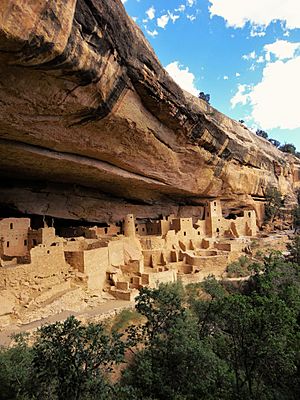Cliff House Sandstone facts for kids
Quick facts for kids Cliff House SandstoneStratigraphic range: Late Campanian ~75Ma |
|
|---|---|

Cliff House Sandstone at Cliff House, Mesa Verde National Park
|
|
| Type | Formation |
| Unit of | Mesaverde Group |
| Sub-units | Barker Dome Tongue, Beechatuda Tongue, Chacra Tongue, Cholla Canyon Tongue, La Ventana Tongue, Ute Canyon Tongue |
| Underlies | Lewis Shale |
| Overlies | Menefee Formation |
| Thickness | 300 m (980 ft) |
| Lithology | |
| Primary | Sandstone |
| Location | |
| Coordinates | 37°10′01″N 108°28′23″W / 37.167°N 108.473°W |
| Region | Colorado |
| Country | |
| Extent | Mesa Verde National Park, San Juan Basin |
| Type section | |
| Named for | Cliff House, Mesa Verde National Park |
| Named by | A.J. Collier |
| Year defined | 1919 |
The Cliff House Sandstone is a special type of rock layer found in the western United States. It's mostly made of sandstone and formed a long, long time ago during a period called the Campanian. This rock unit is famous for forming the tall cliffs at places like Mesa Verde National Park.
Contents
What is the Cliff House Sandstone?
The Cliff House Sandstone is a rock layer made of fine-grained sandstone. Its color can range from white to orange. This sandstone layer is found between two other rock layers: the Menefee Formation below it and the Lewis Shale above it. Think of it like a sandwich, with the Cliff House Sandstone as the filling!
Sometimes, the Lewis Shale layer gets very thin and disappears in the southwest part of the San Juan Basin. When this happens, the Cliff House Sandstone looks exactly like another rock layer called the Pictured Cliffs Formation. In those areas, scientists just use the name "Pictured Cliffs" for both layers combined.
Where Can You See It?
You can see the Cliff House Sandstone in amazing places like Mesa Verde National Park. It forms the impressive cliffs where ancient people built their homes, like the famous Cliff House. That's actually how this sandstone layer got its name! You can also see it at Chaco Canyon.
Layers Within the Sandstone
At Chaco Canyon, the Cliff House Sandstone can be split into three main parts, or "members":
- Lower part: This bottom layer is a thick, strong marine sandstone. It formed in a very active ocean environment.
- Middle part: This section was laid down in deeper water. It has some layers of shale mixed in with the sandstone.
- Upper part: The top layer is another sandstone. It formed in areas like beaches and sandbars along the ancient coastline.
The Cliff House Sandstone is part of a larger group of rocks called the Mesaverde Group in the San Juan Basin. These rocks tell a story about how the Western Interior Seaway — a huge ancient sea that once covered parts of North America — moved back and forth. The Cliff House Sandstone was formed when the sea started to return, depositing sand close to the shore.
How Was It Discovered?
The Cliff House Sandstone was first noticed by a scientist named W.H.Holmes in 1877. He was part of a big exploration trip called the Hayden Survey. He called it the "Upper Escarpment" of the Mesaverde Formation back then.
Later, in 1919, another scientist named A.J. Collier gave this rock layer its official name, the Cliff House Sandstone. He also changed the Mesaverde Formation into the Mesaverde Group, which is a larger collection of rock layers.
Fossils Found in the Sandstone
Scientists have found some cool fossils in the Cliff House Sandstone, especially in Mesa Verde National Park. They've discovered fossilized teeth from ancient sharks! They've also found jaws, teeth, and fins from a fish called Enchodus.
At Chaco Canyon, the lower parts of the sandstone have shells and molds of ancient clams, snails, and even more shark teeth. They've also found fossils of ammonites, which were ancient sea creatures with spiral shells. There are also "trace fossils" called Ophiomorpha nodosa. These are marks left behind by living things, and scientists think they were made by a type of shrimp called Callianasa.
The middle part of the sandstone has fewer trace fossils but more Inoceramus, which were large clams. The upper layers are full of shells from sea creatures, shark teeth, and even small pieces of bone from ancient marine lizards!

